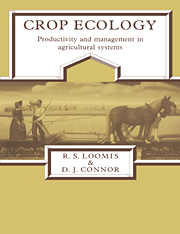Book contents
- Frontmatter
- Contents
- Preface
- Part I Farming systems and their biological components
- 1 Agricultural systems
- 2 Community concepts
- 3 Stability
- 4 Genetic resources
- 5 Development
- Part II Physical and chemical environments
- Part III Production processes
- Part IV Resource management
- References
- Species list
- Conversions and constants useful in crop ecology
- Index
2 - Community concepts
from Part I - Farming systems and their biological components
Published online by Cambridge University Press: 05 June 2012
- Frontmatter
- Contents
- Preface
- Part I Farming systems and their biological components
- 1 Agricultural systems
- 2 Community concepts
- 3 Stability
- 4 Genetic resources
- 5 Development
- Part II Physical and chemical environments
- Part III Production processes
- Part IV Resource management
- References
- Species list
- Conversions and constants useful in crop ecology
- Index
Summary
INTRODUCTION
The main features of crop communities can be described in simple terms. Species and cultivar define genetic content while density, spacing pattern, plant size, and stage of development define structure. The type of community is termed a monoculture when only one crop species is grown in a field at a time; the terms polyculture and mixed cropping apply to communities with two or more cohabiting crop species. Other definitions exist (see, for example, Francis 1989; Vandermeer 1989) but these are the traditional ones employed by agronomists. Most arable farming involves rotations of monocultures over time whereas pastures are mostly polycultures.
COMMUNITY CHANGE
Current views of community structure have evolved from complementary work by agronomists who study managed communities and by botanists concerned with natural communities. In agriculture, small differences in production are important and agronomists make intensive studies of how production rate, competition, limiting factors, and genetic expression influence the behavior of simple communities. Botanists, faced with highly diverse, natural systems give greater attention to species composition of communities in relation to adaptive traits and evolution. A background in plant ecology is useful for agriculturalists. Properties of soils employed in agriculture, for example, derive in part from the natural vegetation under which they developed. Thorough understanding of complex matters such as competition between neighboring plants requires an understanding of the contrast with events in natural communities.
- Type
- Chapter
- Information
- Crop EcologyProductivity and Management in Agricultural Systems, pp. 32 - 59Publisher: Cambridge University PressPrint publication year: 1992
- 7
- Cited by



